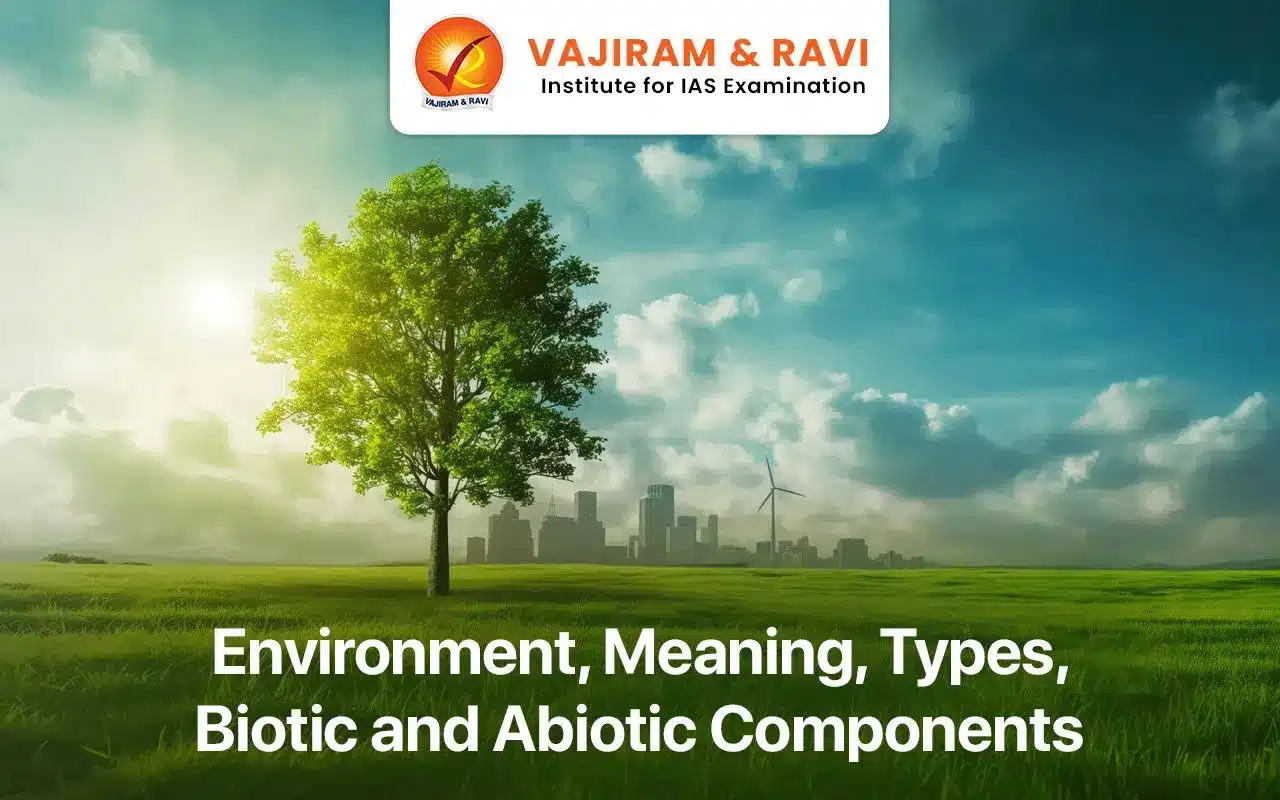Factors of the Environment
Based on basic nature, the environment may be divided into biotic and abiotic factors.- Abiotic: Abiotic components are the non-living physical and chemical factors in the environment. These are the most important determining factors that decide how an organism exists and reacts in the ecosystem.
| Abiotic Factors | |
| Temperature | - Temperature is the most important ecologically relevant
factor that influences the distribution of species across the globe.
- For example: Mango trees cannot thrive in temperate nations such as Canada and Germany, while tuna fish is rarely caught beyond tropical latitudes in the ocean.
- Eurythermal: A few organisms can survive and grow in a wide range of temperatures without altering their internal environment.
|
| Water | - Water is another important factor influencing the physiology of organisms and without it, life is unsustainable.
- Some organisms are tolerant to a wide range of salinity (referred to as euryhaline) while others are restricted to a much narrower range of salinity (referred to as stenohaline).
|
| Light (Energy) | - Light is an important factor for living organisms, particularly autotrophs as they produce food through photosynthesis.
- Light is important for animals also.
|
| Soil | - Soil properties and nature vary significantly based on climate, weathering, transport, sedimentation, and development processes. - All these significantly impact vegetation and determine the type of animals that can be supported on a particular soil area. |
- Biotic: All the biotic factors of the environment including animals, plants, and microbial populations are part of the biosphere. The biotic community is divided into:
- Autotrophs: Autotrophs, which trap solar energy, are the main producers in biotic systems. They are found both in terrestrial ecosystems like rooted plants and aquatic ecosystemslike phytoplankton and macrophytes.
- Heterotrophs: These are called consumers which feed on plants and other animals. Consumers include herbivores (which eat plant material) and carnivores (which eat other animals).
- Saprotrophs: They are also known as decomposers and feed on dead and decaying matter. They break down the complex organic compounds of dead plants and animals into simpler forms and return them to the environment as abiotic factors. They are most important in nutrient cycling within an ecosystem.
- Linkage between biotic and abiotic factors: Linkages among factors of the environment are pathways for the flow of energy and the cycling of nutrients.
- Example: Green plants utilise environmental resources like soil, water, minerals, carbon dioxide, and sunlight to produce food. Animals and plants are ultimately decomposed to the abiotic factors.
- Types of Environment: There can be natural, human-modified and Human-made environments.
Biotic Interactions
Biotic interactions refer to the various relationships among living organisms within an ecosystem. These interactions play a crucial role in shaping the structure, dynamics, and functioning of ecosystems. In these interactions, species can get benefits (+) or get harm (-) or even be neutral (0).- Competition (- -): This occurs when two or more organisms compete for the same limited resources like food, water and habitat.
- Competition can be interspecific (between members of different species) or intraspecific (between members of the same species).
- Competing species often occupy the same trophic level and compete for resources (food), but species on different trophic levels can also compete for space (habitat), water, etc.
- The competitive exclusion principle states that no two species can occupy the same niche in a habitat. Therefore, the competition often results in exclusion, extinction, and migration.
- Competitive exclusion can be avoided if there is resource partitioning. That is, the population evolves to make use of a different resource, a different region of the habitat, or feeds during a different time.
- Predation (+ -): In this interaction, one organism (the predator) hunts, kills, and consumes another (the prey).
- An example is a hawk hunting a mouse for food.
- Parasitism (+ -): This is a relationship where one organism (the parasite) lives on or inside another organism (the host), gaining nutrients and shelter while harming the host.
- Ectoparasites live on the surface of the host. Example: lice feeding on human blood.
- Endoparasites live inside the host. Example: Plasmodium falciparum (malaria parasite) in human blood.
- Mutualism (+ +): This is a mutually beneficial relationship where both organisms gain benefits.
- For instance, bees gather nectar from flowers for food, while flowers get pollinated in the process.
- Commensalism (+ 0): In this relationship, one organism benefits while the other is neither harmed nor benefited.
- An example is barnacles attaching to whales for transportation without affecting the whale.
- Amensalism (- 0): This interaction harms or inhibits one organism, while the other remains unaffected.
- For example, the black walnut tree releases chemicals into the soil that inhibit the growth of other plants, but the tree itself is unaffected.
- Neutralism (0 0): This is a relationship where two organisms have no significant impact on each other.
- For instance, a squirrel and a deer living in the same forest may coexist without interacting significantly.
Response to Abiotic Factors
Abiotic conditions may vary drastically over time, which makes it sometimes difficult for organisms to survive. Species respond differentially to these conditions.- Regulate: Some species can maintain homeostasis through physiological (sometimes behavioural) responses such as maintaining a consistent body temperature and osmotic concentration.
- Example: Humans maintain a constant body temperature of 37℃. Sweating in summer, and shivering and decreasing the surface area of the body in winter are the methods of homeostasis to keep the temperature constant as much as possible.
- Conform: Most animals and plants (99%) are inefficient in homeostasis due to their inability to maintain a constant internal environment. They are called conformists.
- Example: Ectotherms (cold-blooded animals) cannot regulate their internal temperature. Ectotherms include fishes, amphibians, reptiles and insects.
- Migrate: Organisms in distress situations can temporarily relocate to a more friendly environment and then return after the stressful phase is finished.
- Example: Every winter, Keoladeo National Park (Bharatpur) hosts thousands of migratory birds (although birds are endotherms) from Siberia and other severely cold northern regions that become momentarily inhospitable to them.
- Generally, ectotherms migrate to better habitats.
- Suspend: It refers to the state of low metabolic activity in organisms that are unable to migrate to more favourable environments.
- Seed dormancy: Seeds and other vegetative reproductive structures in higher plants serve as a means of stress resistance besides helping in its dispersal; they germinate to generate new plants under favourable moisture and temperature conditions. They do so by reducing their metabolic activity and going into a stage of ‘dormancy’.
- Hibernation: Warm-blooded animals, unable to migrate, may avoid stress in winter by hibernating. They decrease their metabolic rate, slow their body down, their breathing and even their heart.
- Examples: Only mammals hibernate. Bears, chipmunks, groundhogs, dormice, hamsters, hedgehogs, bats, etc. are examples.
- Brumation: Only cold-blooded animals (reptiles and amphibians, which don’t have fur or feathers) brumate, similar to hibernation.
- Their body slows down and they may not move, eat, drink, or excrete for weeks or even months.
- Examples: Frogs, lizards, snakes, and turtles.
- Torpor: It is different from hibernation or brumation as it is for a very short duration, for hours and at any time of the year by decreasing the physical activity.
- Examples: Many types of birds, some types of bats, some squirrels, etc.
- Aestivation: Aestivation is a state of animal dormancy characterised by inactivity and a decreased metabolic rate to avoid the high summer heat and desiccation.
- Examples: earthworms, frogs, bees, snails, salamanders, tortoises, fishes, crocodiles, etc.
Adaptations
Adaptation is a heritable trait that allows an organism, such as a plant or animal, to survive and reproduce in its environment by morphological, physiological, or behavioural means. Adaptations are evolved over long evolutionary periods and are genetically fixed.- Morphological adaptation: Some species have morphological adaptations (changes in the body structure).
- Thick cuticles or thorns (for less water loss in evo-transpiration) and CAM photosynthetic pathway in desert plants. Some plants (for example - opuntia) have flattened stems, working as leaves.
- Mammals in cooler climates have shorter ears and limbs to reduce heat loss. (Known as the Allen's Rule).
- Physiological adaptation: Some species have physiological adaptations that allow them to respond swiftly under stressful situations.
- Many fish thrive in the below-zero temperature of the Antarctic Ocean by showing a fascinating array of biochemical adaptations.
- Kangaroo rats in North American deserts are capable of meeting all their water requirements through their internal fat oxidation.
- Many tribes in the high altitude of the Himalayas have a higher red blood cell count than people living in the plains to compensate for low oxygen availability.
- Many African tribes have sickle-celled RBCs to evade malaria.
- Behavioural adaptation: Some organisms show behavioural responses to variations in environmental factors.
- Some species burrow into the soil to hide in extreme heat.
- Seasonal migration by birds and animals are examples of behavioural adaptations.
Environmental Issues
Human activities such as overpopulation, consumerism, and deforestation have led to environmental issues such as climate change, pollution, and loss of biodiversity. etc.- Pollution: Pollution is the introduction of harmful materials into the environment, known as pollutants, that cause undesirable changes in the environment. Along with harming human health, pollution can cause a variety of ecological effects.
- Air Pollution: The main factors contributing to urban air quality deterioration are the burning of fossil fuels through rapid industrialisation, power generation and urban transportation.
- Air pollutants include Carbon Monoxide, Lead, Nitrogen oxides, Ozone, Sulfur Dioxide and Particulate Matter, etc.
- Water pollution: It is caused by both synthetic and biological contaminants, and damages aquatic environments.
- For example, organic matter that decomposes in water can reduce its oxygen content, resulting in potentially harmful effects for organisms such as fish.
- Air Pollution: The main factors contributing to urban air quality deterioration are the burning of fossil fuels through rapid industrialisation, power generation and urban transportation.
- Climate change: Human-induced climate change increases greenhouse gas emissions, causing global temperatures to rise.
- This results in the melting of glaciers, rising sea levels, disrupted ecosystems, and an increase in severe weather events such as droughts, floods, heat waves, and wildfires.
- Loss of biodiversity: From the Amazon to the tundra, biodiversity is crucial for the planet's ecological balance.
- It is being threatened by human activities like deforestation, urbanization, and pollution.
- Its loss leads to species extinction, food and water scarcity, and reduced carbon sequestration.
- Population growth: According to the UN, the world's population is expected to reach 9.7 billion by 2050.Without sustainable development, overpopulation can lead to food and water scarcity and other resource depletion and can also exacerbate issues like waste disposal, pollution, and deforestation.
- Ozone layer depletion: Reduced ozone levels as a result of ozone depletion mean less protection from the UV-B radiation causing several skin diseases including cancer.
- Land degradation: India, with about 32% of its land under degradation and 25% under desertification, has a huge task cut out to ensure sustainable land management.
Conservation Efforts
To protect our environment from the above-mentioned issues, urgent conservation efforts are needed. Some of them are being described here.- Pollution control: It can be controlled by checking the sources of pollution by implementing air quality standards, promoting clean energy fuels improving waste management practices, etc.
- Checking land degradation: Prevention of land degradation due to desertification and deforestation is critical to achieving sustainable development.
- MoEFCC works on various schemes like National Action Programme to Combat Desertification, National Mission for a Green India, Compensatory afforestation under CAMPA, etc.
- Sustainable resources management: UN Sustainable Development Goals also known as the 2030 Agenda for Sustainable Development aims at transforming the lives and livelihood of the people across the globe.
- NITI Aayog is the nodal institution for achieving SDGs in India.
- Biodiversity conservation: When an ecosystem is protected, the biodiversity of all levels are conserved automatically. Biodiversity can be conserved using both In-situ and Ex-situ conservation efforts.
Environment UPSC PYQs
Question 1: Consider the following statements: (UPSC Prelims 2019)- The Environment Protection Act, of 1986 empowers the Government of India to state the requirement of public participation in the process of environmental protection, and the procedure and manner in which it is sought
- lay down the standards for emission or discharge of environmental pollutants from various sources
- 1 only
- 2 only
- Both 1 and 2
- Neither 1 nor 2
- The NGT has been established by an Act whereas the CPCB has been created by an executive order of the Government.
- The NGT provides environmental justice and helps reduce the burden of litigation in the higher courts whereas the CPCB promotes cleanliness of streams and wells, and aims to improve the quality of air in the country.
- 1 only
- 2 only
- Both 1 and 2
- Neither 1 nor 2
Last updated on November, 2025
→ Check out the latest UPSC Syllabus 2026 here.
→ Join Vajiram & Ravi’s Interview Guidance Programme for expert help to crack your final UPSC stage.
→ UPSC Mains Result 2025 is now out.
→ UPSC Notification 2026 is scheduled to be released on January 14, 2026.
→ UPSC Calendar 2026 is released on 15th May, 2025.
→ The UPSC Vacancy 2025 were released 1129, out of which 979 were for UPSC CSE and remaining 150 are for UPSC IFoS.
→ UPSC Prelims 2026 will be conducted on 24th May, 2026 & UPSC Mains 2026 will be conducted on 21st August 2026.
→ The UPSC Selection Process is of 3 stages-Prelims, Mains and Interview.
→ UPSC Result 2024 is released with latest UPSC Marksheet 2024. Check Now!
→ UPSC Prelims Result 2025 is out now for the CSE held on 25 May 2025.
→ UPSC Toppers List 2024 is released now. Shakti Dubey is UPSC AIR 1 2024 Topper.
→ UPSC Prelims Question Paper 2025 and Unofficial Prelims Answer Key 2025 are available now.
→ UPSC Mains Question Paper 2025 is out for Essay, GS 1, 2, 3 & GS 4.
→ UPSC Mains Indian Language Question Paper 2025 is now out.
→ UPSC Mains Optional Question Paper 2025 is now out.
→ Also check Best IAS Coaching in Delhi
Environment FAQs
Q1. What are the types of environments?+
Q2. What are the components of the environment?+
Q3. What is climate change?+
Tags: environment quest

















